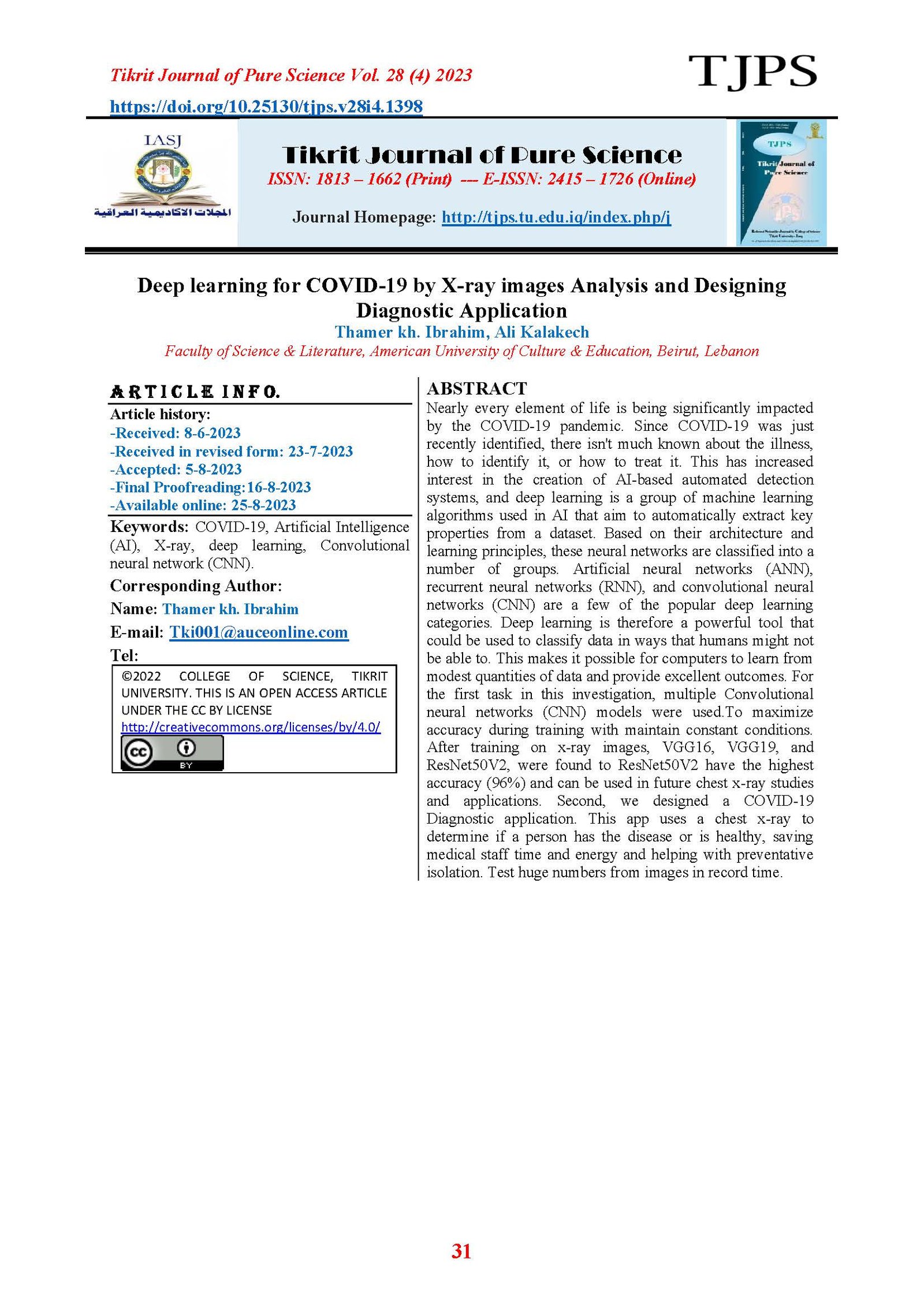Deep learning for COVID-19 by X-ray images Analysis and Designing Diagnostic Application
Main Article Content
Abstract
Nearly every element of life is being significantly impacted by the COVID-19 pandemic. Since COVID-19 was just recently identified, there isn't much known about the illness, how to identify it, or how to treat it. This has increased interest in the creation of AI-based automated detection systems, and deep learning is a group of machine learning algorithms used in AI that aim to automatically extract key properties from a dataset. Based on their architecture and learning principles, these neural networks are classified into a number of groups. Artificial neural networks (ANN), recurrent neural networks (RNN), and convolutional neural networks (CNN) are a few of the popular deep learning categories. Deep learning is therefore a powerful tool that could be used to classify data in ways that humans might not be able to. This makes it possible for computers to learn from modest quantities of data and provide excellent outcomes. For the first task in this investigation, multiple Convolutional neural networks (CNN) models were used.To maximize accuracy during training with maintain constant conditions. After training on x-ray images, VGG16, VGG19, and ResNet50V2, were found to ResNet50V2 have the highest accuracy (96%) and can be used in future chest x-ray studies and applications. Second, we designed a COVID-19 Diagnostic application. This app uses a chest x-ray to determine if a person has the disease or is healthy, saving medical staff time and energy and helping with preventative isolation. Test huge numbers from images in record time.
Article Details

This work is licensed under a Creative Commons Attribution 4.0 International License.
Tikrit Journal of Pure Science is licensed under the Creative Commons Attribution 4.0 International License, which allows users to copy, create extracts, abstracts, and new works from the article, alter and revise the article, and make commercial use of the article (including reuse and/or resale of the article by commercial entities), provided the user gives appropriate credit (with a link to the formal publication through the relevant DOI), provides a link to the license, indicates if changes were made, and the licensor is not represented as endorsing the use made of the work. The authors hold the copyright for their published work on the Tikrit J. Pure Sci. website, while Tikrit J. Pure Sci. is responsible for appreciate citation of their work, which is released under CC-BY-4.0, enabling the unrestricted use, distribution, and reproduction of an article in any medium, provided that the original work is properly cited.
References
Abraham, B., & Nair, M. S. (2020). Computer-aided detection of COVID-19 from X-ray images using multi-CNN and Bayesnet classifier. Biocybernetics and Biomedical Engineering, 40(4), 1436–1445.
AL-Malali, M. K., & Ramo, F. M. (2021). Behavioral Sense Classification using Machine Learning Algorithms. In Doctoral dissertation, Mosul University. Mosul University.
Alzubaidi, L., Zhang, J., Humaidi, A. J., Al-Dujaili, A., Duan, Y., Al-Shamma, O., Santamaría, J., Fadhel, M. A., Al-Amidie, M., & Farhan, L. (2021). Review of deep learning: concepts, CNN architectures, challenges, applications, future directions. In Journal of Big Data (Vol. 8, Issue 1). Springer International Publishing. https://doi.org/10.1186/s40537-021-00444-8
Bansal, M., Kumar, M., Sachdeva, M., & Mittal, A. (2021). Transfer learning for image classification using VGG19: Caltech-101 image data set. Journal of Ambient Intelligence and Humanized Computing, 1–12.
Castillo, O., Melin, P., & Kacprzyk, J. (2020). Intuitionistic and type-2 fuzzy logic enhancements in neural and optimization algorithms: Theory and applications (Vol. 862). Springer Nature.
Cleophas, T. J., & Zwinderman, A. H. (2020). Machine learning in medicine - a complete overview. Machine Learning in Medicine - A Complete Overview, 1706, 1–667. https://doi.org/10.1007/978-3-030-33970-8
He, K., Zhang, X., Ren, S., & Sun, J. (2016). Deep residual learning for image recognition. Proceedings of the IEEE Conference on Computer Vision and Pattern Recognition, 770–778.
Kamil, M. Y. (2021). A deep learning framework to detect Covid-19 disease via chest X-ray and CT scan images. International Journal of Electrical & Computer Engineering (2088-8708), 11(1).
Kamilaris, A., & Prenafeta-Bold, F. X. (2018). Deep learning in agriculture: A survey. Computers and Electronics in Agriculture, 147, 70–90.
Kassania, S. H., Kassanib, P. H., Wesolowskic, M. J., Schneidera, K. A., & Detersa, R. (2021). Automatic detection of coronavirus disease (COVID-19) in X-ray and CT images: a machine learning based approach. Biocybernetics and Biomedical Engineering, 41(3), 867–879.
Khan, S., Rahmani, H., Shah, S. A. A., Bennamoun, M., Medioni, G., & Dickinson, S. (2018). A guide to convolutional neural networks for computer vision (Vol. 8, Issue 1). Springer.
Organization, W. H. (2020). WHO announces COVID-19 outbreak a pandemic.
Shambhu, S., Koundal, D., Das, P., & Sharma, C. (2021). Binary classification of covid-19 ct images using cnn: Covid diagnosis using ct. International Journal of E-Health and Medical Communications (IJEHMC), 13(2), 1–13.
Tahir, H., Iftikhar, A., & Mumraiz, M. (2021). Forecasting COVID-19 via registration slips of patients using resnet-101 and performance analysis and comparison of prediction for COVID-19 using faster r-cnn, mask r-cnn, and resnet-50. 2021 International Conference on Advances in Electrical, Computing, Communication and Sustainable Technologies (ICAECT), 1–6.
Tang, S., Wang, C., Nie, J., Kumar, N., Zhang, Y., Xiong, Z., & Barnawi, A. (2021). EDL-COVID: Ensemble deep learning for COVID-19 case detection from chest X-ray images. IEEE Transactions on Industrial Informatics, 17(9), 6539–6549.
Trivedi, N. K., Simaiya, S., Lilhore, U. K., & Sharma, S. K. (2021). COVID-19 Pandemic: Role of Machine Learn-ing & Deep Learning Methods in Diagnosis. Int J Cur Res Rev, 13(06), 150–156.
Uzun, O. (2021). Artificial intelligence application in covid-19 diagnosis and orediction using CT scan. A THESIS TO THE INSTITUTE OF GRADUATE STUDIES OF NEAR EAST UNIVERSITY.
Yang, D., Martinez, C., Visuña, L., Khandhar, H., Bhatt, C., & Carretero, J. (2021). Detection and analysis of COVID-19 in medical images using deep learning techniques. In Scientific Reports (Vol. 11, Issue 1). https://doi.org/10.1038/s41598-021-99015-3
